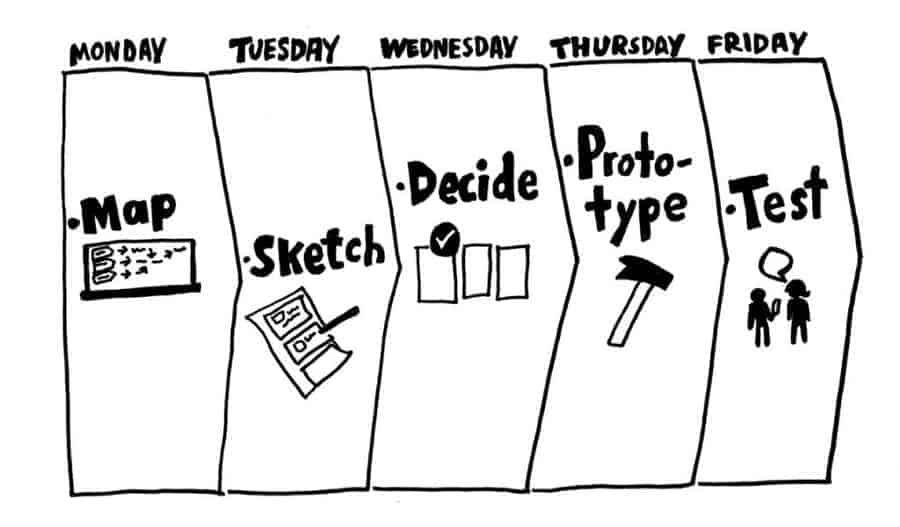Get more organized with these Design Sprint scenarios
There are many cases and reasons to run a Design Sprint. Maybe you have participated in a Design Sprint before, or perhaps you are deciding if now is the right time to lead, plan, and run one yourself. In this post, we’ll review what a Design Sprint is, and discuss some of the ideal times to run one. Before jumping in, let’s first cover what a Design Sprint is.
What is a Design Sprint?
The Design Sprint, originally developed at Google Ventures, quickly became a staple in the facilitation and innovation realms. Nowadays, companies of all shapes and sizes are using the Design Sprint method and having great success. Google Ventures has run over 150 design sprints with companies like Slack, Flatiron Health, and Blue Bottle Coffee.
A Design Sprint is a five-day series of activities and workshops that help answer critical business questions and solve big challenges through design, prototyping and testing ideas directly with users. Design Sprints guide a team through the design thinking process.
For more on the process and benefits of design thinking, check out this post.
The benefits of a Design Sprint are creating a shortcut to the endless debate cycle, and compressing months of time into a single week.

The Design Sprint Five-Day Process
Design Sprints have helped many teams and organizations, both large and small, innovate by rapidly iterating and prototyping new ideas. GV puts it best, comparing a Design Sprint to a superpower: “You can fast-forward into the future to see your finished product and customer reactions, before making any expensive commitments.”
We understand every team and every teams’ needs are different. Depending on your industry, circumstances, and needs, Design Sprints have various purposes. For example, they can align a team around a shared vision, help tackle vital business challenges, or identify new breakthrough products or features. Design Sprints can and should be used as a tool to help your team identify what jobs need to be done, who needs to do them, what’s important to focus on, and how they will get from point A to point B to point C.

Top Reasons to Run a Design Sprint
With all that being said, it may seem daunting or overwhelming trying to determine if now is a good time for your team to turn to a Design Sprint. Most teams and organizations likely have a challenge that would benefit from a Design Sprint. But to make this easier for you, we at Voltage Control have identified the following five scenarios as excellent times to consider a Design Sprint
1. When kicking off a new initiative
You’re about to kick off a brand new project or product. Congratulations! During this time, you probably want momentum, excitement, and alignment from the start. Running a Design Sprint can help focus your team going into the new initiative, and also help surface and resolve any debate or conflicting opinion during the process.
Pro Tip: Consider hiring an outside facilitator when dealing with big or sensitive decisions. They are removed from office politics and help to increase engagement and positivity in the group throughout the Design Sprint. An outside facilitator is also a fresh new face and personality who can help to break old patterns and create new ones for optimum productivity.
2. When looking for new breakthrough features for a product
Design Sprints are an excellent way to push through confusion and inertia to come up with new ideas, and find out quickly if your customers will respond positively to them. Because Design Sprints help you accomplish months of work in a week, they will be especially impactful in this scenario.
3. When you need to switch gears or iterate on a current product
The need to pivot is especially common in fast-paced industries or organizations. You are likely often iterating on your business or product model, and now want to explore the right way to go next. This also probably means various team members from across the organization need to be involved, to ensure the outcome is both feasible and successful. Design Sprints can be most effective when the problem is big or meaningful enough that different teams need to work together to find a solution. It’s not just an engineering challenge, or a design problem, but something larger that requires subject matter experts from different areas to truly work together and move the project or product forward. Onward and upward!
4. When you haven’t talked to your users enough
Too often, we’ve seen products being built without the proper or full understanding of the customer (or the job the customer expects the product to do for them). If this sounds familiar, or even if you simply think there’s room to improve, now may be a great time for a Design Sprint! The Design Sprint process can help unpack the problem space and zero in on the cause of misalignment. In this case, a Design Sprint will help refine your understanding of how to address your customers’ needs.
5. When an A/B test can’t answer your questions
Consider whether an A/B test would be an appropriate method of answering your big questions. If not, a Design Sprint may be a better idea. A/B testing is great for testing incremental changes, but Design Sprints (and similar research-based discovery processes) are much better suited for more strategic initiatives and exercises.

If this is your first time planning a Design Sprint, don’t worry! We cover everything you need to know for that in our post here. We also understand various circumstances – such as the ongoing COVID-19 pandemic or having employees located in different cities –may result in the need for virtual events, therefore we’ve also adapted our tried-and-true Design Sprint model for remote work.
Finally, whenever you do decide to run a Design Sprint, don’t forget the essentials that come after the Design Sprint. Some tips and tricks post Design Sprint include:
- Debrief: Recap the Design Sprint and define what you learned with the group
- Communicate: Also let your larger organization or team know what you learned from the Design Sprint
- Align: Ensure everyone is on the same page following the Design Sprint regarding next steps (and with clear task owners)
- Read: We have seen so many companies struggle in the post Design Sprint world, so we wrote an entire book about it! You can find more information in “Beyond the Prototype: A roadmap for navigating the fuzzy area between ideas and outcomes”

Good luck and happy Sprinting!
You Don’t Have to Design Sprint Alone
If you want to run a Design Sprint at your company but are overwhelmed at the idea of planning and facilitating it, you’re in the right place. Voltage Control designs and leads Design Sprints for companies large and small.
Having a professional facilitator run your Design Sprint ensures that you can focus on the ideas and the work, not the logistics or “doing it right.” Reach out to us at hello@voltagecontrol.com or get in touch with us here if you want to talk about running a Design Sprint at your company.



